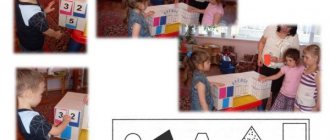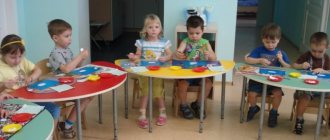Development of creative abilities in children through theatrical activities
The article shows the importance of children's creative potential in accordance with the Federal State Educational Standard. Arguments are given in favor of using theatrical activities for this purpose, in particular theatrical games.
Key words: creative abilities, creative development, theatrical activity.
Relevance . Throughout human history, creativity has been a kind of engine that has helped people move to a new stage. Therefore, creatively active people were often (though not always) held in high esteem. It was their new ideas that showed new goals and transformed reality. And in our time this does not lose relevance. After all, creativity is applicable in all areas of human activity. And no matter how gifted a person is, any abilities require development, including creative ones. It is known that childhood is the most productive period in a person’s life, when the foundations of his future personality are laid and natural abilities are developed. Creativity is no exception.
The Federal State Educational Standard directs us to create favorable conditions for the development of the abilities of each child and his creative potential [1, paragraph 1.6]. In the section Artistic and aesthetic development (clause 2.6), among the assigned tasks, the implementation of the child’s independent creative activity in various directions is indicated: fine arts, musical direction, constructive modeling. In the search for effective methods for developing creativity in children, we must not forget about the theater, which includes all these areas of creative activity. After all, theatrical activity as a source of development of creative abilities is a means that can contribute to the development of children's individuality, the disclosure of their abilities, and creative activity.
Literature analysis. Rubinstein S.L. gave a prominent place to the problem of abilities, considering the problems of inclinations, the development of abilities, the relationship between giftedness and personality, giftedness and mental functions, general and special giftedness [2]. Teplov B.M. identified signs that reflect the essence of human abilities [3, p.9].
Creativity, according to researchers such as V.N. Druzhinina, E.L. Soldatova and others, can be developed. It is especially effective to influence its formation during sensitive periods. Preschool age and adolescence are such periods [4].
Children's creativity is one of the pressing problems of preschool pedagogy and child psychology. It was studied by L. S. Vygotsky, A. N. Leontiev, L. A. Venger, N. A. Vetlugina, B. M. Teplov, O. M. Dyachenko, A. N. Volkov and others.
Presentation of the main material . Before we talk about creativity, let's first understand what abilities are in general. In psychology, ability is understood as a complex of physical and mental qualities of a person that provide him with the opportunity to engage in a certain type of activity.
Ability is a set of innate and individually acquired psychological properties of a person, which are a subjective condition for the successful performance of a certain type of activity [5, p. 112].
Creativity is, firstly, a human activity that generates something new, different from the old in its uniqueness, originality and social-historical uniqueness, and secondly, it is the highest form of human activity and independent activity [5, p. 117].
We can say that creativity is a necessary condition for personal development.
It is obvious that theatrical activities help to develop in children the ability to perceive novelty, the ability to improvise, the ability to express themselves, and creative activity.
Theatrical games, as a component of theatrical activities, provide a large field of activity for the manifestation and development of the child’s creative abilities. They encourage creative activity, which manifests itself in stimulating children’s imagination, improvisation in composing short stories and fairy tales, and in children’s desire to independently look for expressive means to create an image, using movements, posture, facial expressions, different intonation and gestures. Theatrical games help remove inhibitions in children, strengthen their self-confidence, which in turn stimulates the development of spiritual potential and creative activity.
Theatrical games can be divided into the following groups: games - dramatization and director's.
Dramatization games are the depiction and acting out of any plot (this is finger theater; bi-ba-bo theater; puppet theater; dramatization using masks; improvisation).
A dramatization game is an artistic activity of a preschooler that meets their needs for something unusual, the desire to reincarnate and feel like someone else. In dramatization games, the child, playing a role as an “artist,” independently creates an image using a set of means of verbal and nonverbal expressiveness.
Director's games are games where the plot is invented and played out through the roles that the child offers to the toys, most often without including himself in the game plot, being outside the situation being played out. Being individual, director's play requires the child to show the maximum degree of his initiative, imagination, and creativity. If in a role-playing game the action reaches a dead end, then the impetus for the subsequent development of the plot can be the idea of any of the players. In a director's game, there is no help for the child, and he needs to mobilize all his capabilities so that the game can continue [6]. But in older preschool age, it can already be included in the joint activities of children, where the role of “toys” is played by other children.
At the same time, it is necessary to avoid some mistakes so as not to deviate from the goal of developing the creative potential of children. Let's list these errors. Firstly, the displacement is intact. The desire to achieve good results forces teachers to memorize with children not only the text, but also intonation and movements during a justifiably large number of individual and collective rehearsals. This deprives children of the manifestation of individuality, the disclosure of their creative potential, deprives them of freedom of action, which in turn develops the memory and speech of children, but shifts them away from the goal of developing children’s creative abilities. The second mistake is the opposite: the complete non-interference of adults, except for the preparation of attributes (and the same ones for several years), which also does not contribute to the development of children’s creative activity [6, p.1].
The conditions for the manifestation of independence and creativity of older preschool children in theatrical games are as follows: the content of the games must correspond to the interests and capabilities of the children; pedagogical support is built taking into account the gradual increase in independence and creativity of the child; The theatrical and play environment should be dynamically changing, and children take part in its creation.
Thus, theatrical activities and, in particular, theatrical games are a good opportunity to reveal the creative potential of a child and nurture the creative orientation of the individual.
Literature:
- Federal State Educational Standard [Electronic resource] Access mode: file:///C:/Users/MiK/Downloads/fgos_ru_doshk.pdf %20(1).pdf
- Theoretical views of S. L. Rubinstein on the problem of abilities and giftedness / [Electronic resource] Access mode: https://www.e-reading.club/chapter.php/1037944/149/Shadrikov_-_Ot_individa_k_individualnosti.html
- Teplov B. M. Abilities and giftedness / Problems of individual differences / [Electronic resource] M, 1961, p. 9–20 Access mode: https://docplayer.ru/35624554-Teplov-bm-sposobnosti-i-odarennost.html
- Psychodiagnostics of creative abilities in students of humanitarian and technical universities / Study of creative abilities in psychology / [Electronic resource] Access mode: https://studbooks.net/1616325/psihologiya/izuchenie_tvorcheskih_sposobnostey_psihologii
- Permyakov A. A., Morozov V. V., Zaredinogva E. R. A short dictionary of pedagogical concepts: a textbook for students of higher educational institutions / A. A. Permyakov, V. V. Morozov, E. R. Zaredinova. — Ed. 2nd, rev. And additional - Krivoy Rog, Simferopol: Vidavnichy Dim, 2010. - 144 p.
- Akulova O. Theatrical games / Preschool education, 2005, No. 4, p. 24.
MAGAZINE Preschooler.RF
Theatrical activity as a means of developing the creative abilities of preschool childrenKalitskaya E.N., teacher, kindergarten No. 46, Pushkin district of St. Petersburg
Theatrical activities in kindergarten are a good opportunity to reveal the creative potential of the child and nurture the creative orientation of the individual. Children learn to notice interesting ideas in the world around them, embody them, create their own artistic image of a character, they develop creative imagination, associative thinking, and the ability to see unusual moments in the ordinary. In pedagogical literature, theatrical play is also considered as a means of children’s development.
Theater is one of the most spectacular and accessible forms of art for children, since, taking into account certain characteristics of preschool children (emotionality, sensory consciousness, imagination, empathy), it has a strong developmental influence on the emotional sphere of the child, while performing communicative, regulatory, cathartic functions.
Throughout the history of mankind and civilizations, theatrical art has always been associated with man’s desire to understand the world. The idea that theater should be the embodiment of a person’s spiritual life, a means of education, was actively developed by V.Y. Nemirovich-Danchenko and K.S. Stanislavsky - reformers of the Russian theater.
Theater is a powerful force of spiritual influence on people. In other forms of art, the viewer perceives only the result of creativity. In the theater, the viewer is not only present at the creative process itself, but also takes part in it and empathizes.
This feature of theatrical art manifests itself with particular force when preschool children perceive performances. They have not yet developed the ability to compare the stage and life, which is why they are so characterized by spontaneity of perception, when the lines between the conventions of art and reality are erased and absolute trust arises in everything that happens on the stage. Children rarely separate the actor from the role, equating the stage with reality. They understand and feel more than they can express. Hence the educational role of the theater is extremely high. That is, the creative process of theatrical action, the child’s complete trust in what is happening in the performance, play, dramatization game, the focus of children’s perception on sympathy, empathy and even complicity, allows us to talk about the serious possibilities of theatrical activity in the development of the creative abilities of older preschoolers.
It is well known that play is one of the main types of children’s activities, during which preschoolers develop the ability to feel the emotional states of others, the ability to take the position of an experiencer and, by performing certain actions, to play out various options for relationships with other people. This is the developmental potential of theatrical games in the moral education of preschool children.
Theatrical games or dramatization games contribute to the development of mental processes and various qualities of the child’s personality - independence, initiative, emotional responsiveness, imagination. Many psychologists have paid attention to the existence of a special, emotional game plan. They emphasized that the main meaning of the game lies in a variety of experiences that are significant for the child, that in the process of play there are deep transformations of the initial, affective tendencies and plans that have developed in his life experience.
Confirmation of this can be found in the works of the famous domestic scientist I.M. Sechenov, who proved that gaming experiences leave a deep imprint on the child’s mind. Repeated repetition of the actions of adults and imitation of their moral qualities influence the formation of the same qualities in the child.
Understanding the game as “emotionally effective exploration of the world ,” as defined by A.N. Leontiev, is extremely important for the practice of preschool education. In children's play, emotions are often manifested that are not yet available to them in life, and in theatrical play, emotions are programmed in the game image that the child portrays, in the plot within which the game character acts. The more intense the children’s experiences during theatrical games, the deeper the imprint they will leave in the child’s mind and influence the nature of his manifestations in interaction with others and social behavior.
Taking part in a theatrical game, the child takes on a certain role, the image of various game characters, which gives a feeling of emotional unity and involvement with them, and allows him to realize and express his own feelings inherent in children, thereby manifesting and enriching his emotional and sensory experience. Subsequently, the child begins to identify himself with his favorite characters. The ability for such identification allows, through the images of theatrical play, to influence children and form the experience of empathic behavior. The assimilation of various patterns of actions and deeds also occurs, which gives preschoolers the opportunity not only to better understand and recognize their inner world, but also teaches them to make moral choices.
Theatrical activities belong, according to I.A. Kolesnikova, to artistic and figurative pedagogical means, the essence of which is that a conscious image turns into a mental image, a unique unit of thinking. Having become an internal form, it acquires independence of life and the ability to influence the activity of the subject. An image is capable of performing in the pedagogical process the function of a model that controls further human behavior, that is, a regulatory or normalizing function.
Dramatization or theatrical production represents the most frequent and widespread type of children's creativity. V.G. Petrova notes that theatrical activity is a form of experiencing the impressions of life, lies deep in the nature of children and finds its expression spontaneously, regardless of the wishes of adults. The greatest value of children's theatrical activities lies in the fact that dramatization is directly related to the game (L. S. Vygotsky, N. Ya. Mikhailenko), therefore it is the most syncretic, i.e. contains elements of the most diverse types of creativity. Children themselves compose, improvise roles, and stage some ready-made literary material.
In theatrical activities, actions are not given ready-made. A literary work only suggests these actions, but they still need to be recreated with the help of movements, gestures, and facial expressions. The child chooses his own means of expression and adopts them from his elders. The large and varied influence of theatrical activities on a child’s personality allows them to be used as a strong but unobtrusive pedagogical tool, since the child himself experiences pleasure and joy. The educational possibilities of theatrical activities are enhanced by the fact that their topics are practically unlimited. It can satisfy the diverse interests of children.
It is theatrical activities that are a unique means of developing children’s creative abilities. Solving problems aimed at developing creative abilities requires the definition of a different technology, the use of theatrical techniques and their combinations in a holistic pedagogical process. At the same time, in practice we observe that the developmental potential of theatrical activities is not used enough. How can this be explained?
- Introduction to the theater is not widespread, which means that some children remain outside this type of activity.
- Misunderstanding of the importance of theatrical activities for the development of a child.
- Preschoolers have no experience in perceiving theatrical art. There is an unsystematic and superficial familiarization with the theater in kindergarten and in the family, which develops in children the idea of an accessible perception of the stage design of works without special knowledge.
- Theatrical games are used mainly as a “spectacle” at holidays. The child is taught to be a “good artist” , to memorize the text, intonation, and movements. However, the skills mastered in this way are not transferred to free play activities.
- Non-interference of an adult in theatrical play. The children are left to their own devices, the teacher prepares the attributes for the theater. The same set of hats and masks, elements of the heroes’ costumes move from group to group. Younger preschoolers are attracted to this because of the opportunity to change clothes, but the older preschooler is not satisfied because it does not correspond to his cognitive interests, level of development of mental processes, and opportunities for self-realization in creative activity.
The consequence is the complete absence of theatricality in the play experience of children 5-7 years old, even if they have an interest in this activity and a need for it. At the same time, preschoolers often do not have the readiness for independent theatrical activities. Only a few kindergarten graduates have a sufficient level of understanding of theater and gaming skills that allows them to organize independent theatrical activities. A contradiction arises: on the one hand, there is recognition by art history and pedagogical science of the importance of theater in the emotional and creative development of a child. On the other hand, there is a shortage of theatrical art in children's lives.
We see a solution to the identified contradictions in the special organization of interaction between the music director, teachers, children and their parents, namely in pedagogical support for the development of creative abilities of children of senior preschool age in theatrical activities.
Joint activities between the teacher and the children. Work on theatrical activities is carried out 3 times a week in the afternoon and was carried out in two interrelated areas.
The first direction is classes to develop children’s attention, imagination, and movements.
The second direction is working on the role.
In the course of work in the first direction, the following tasks were solved: to ensure that the child’s knowledge about life, his desires and interests are naturally woven into the content of theatrical activities; maintain the creative nature of theatrical activities, encourage children to strive to create a holistic artistic image with the help of gestures, facial expressions and movements. The second direction in theatrical activities is working on the role:
- Introduction to the dramatization: what is it about? What are the main events in it?
- Meet the heroes of the dramatization:
- drawing up a verbal portrait of the hero;
- fantasizing about his home, relationships with parents, friends, inventing his favorite dishes, activities, games;
- composing various incidents from the hero’s life that were not included in the dramatization;
- analysis of invented actions;
- work on stage expressiveness: determining appropriate actions, movements, gestures of characters, places on the stage; facial expressions, intonation;
- preparation of theatrical costume.
Developmental environment. It is necessary to fill the developing environment with different types of theaters. All material is conveniently placed for children to use freely. It is also important to create conditions for further enriching children's experiences.
The environment is one of the main means of developing a child’s personality, the source of his individual knowledge and social experience. When creating the environment, we tried to provide conditions for the independent creativity of each child.
In a group, you can set up a theater area, as well as a “corner” of privacy, where the child can be alone or rehearse a role in front of a mirror, or look at the illustrations for the play again. In order to realize the individual interests of children, it is necessary to place different types of puppet theater and children's drawings in the area of theatrical activities. To develop the curiosity and research interest of children, the theatrical activity area contains a variety of natural and waste materials, fabrics, and costumes for mummers.
Thus, when creating a developmental environment, the following principles are taken into account:
- ensuring a balance between joint and individual activities of children;
- organization of “privacy zones” ;
- providing the right and freedom of choice;
- creating conditions for modeling, searching and experimentation;
- multifunctional use of premises and equipment.
Work with parents is aimed at informing adults about the importance of theatrical activities for preschoolers. Also, the interaction of kindergarten teachers with parents is aimed at familiarizing themselves with the forms of organizing joint activities of children, parents and teachers with children.
Thus, pedagogical support for the development of creative abilities in theatrical activities contributes to:
- development in children of a sustainable interest in theatrical and play activities;
- improving children’s performing skills, their desire to look for means to create a character’s image, using movement, facial expressions, gesture, intonation;
- enriching children's vocabulary, the ability to use direct and indirect speech in dramatizations of fairy tales and stories;
- improving the ability to retell fairy tales coherently and expressively, independently composing your own fairy tales and stories using dolls;
- development of memory, thinking, imagination, speech, attention of children;
- increasing the level of development of children in theatrical activities.
| Next > |






